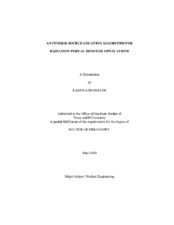| dc.description.abstract | Radiation portal monitors are being deployed at border crossings throughout the world to prevent the smuggling of nuclear and radiological materials; however, a tension exists between security and the free-flow of commerce. Delays at ports-of-entry have major economic implications, so it is imperative to minimize portal monitor screening time. We have developed an algorithm to locate a radioactive source using a distributed array of detectors, specifically for use at border crossings.
To locate the source, we formulated an optimization problem where the objective function describes the least-squares difference between the actual and predicted detector measurements. The predicted measurements are calculated by solving the 3-D deterministic neutron transport equation given an estimated source position. The source position is updated using the steepest descent method, where the gradient of the objective function with respect to the source position is calculated using adjoint transport calculations. If the objective function is smaller than a predetermined convergence criterion, then the source position has been identified.
To test the algorithm, we first verified that the 3-D forward transport solver was working correctly by comparing to the code PARTISN (Parallel Time-Dependent SN). Then, we developed a baseline scenario to represent a typical border crossing. Test cases were run for various source positions within each vehicle and convergence criteria, which showed that the algorithm performed well in situations where we have perfect knowledge of parameters such as the material properties of the vehicles. We also ran a sensitivity analysis to determine how uncertainty in various parameters-the optical thickness of the vehicles, the fill level in the gas tank, the physical size of the vehicles, and the detector efficiencies-affects the results. We found that algorithm is most sensitive to the optical thickness of the vehicles. Finally, we tested the simplifying assumption of one energy group by using measurements obtained from MCNPX (Monte Carlo N-Particle Extended). These results showed that the one-energy-group assumption will not be sufficient if the code is deployed in a real-world scenario. While this work describes the application of the algorithm to a land border crossing, it has potential for use in a wide array of nuclear security problems. | en |


